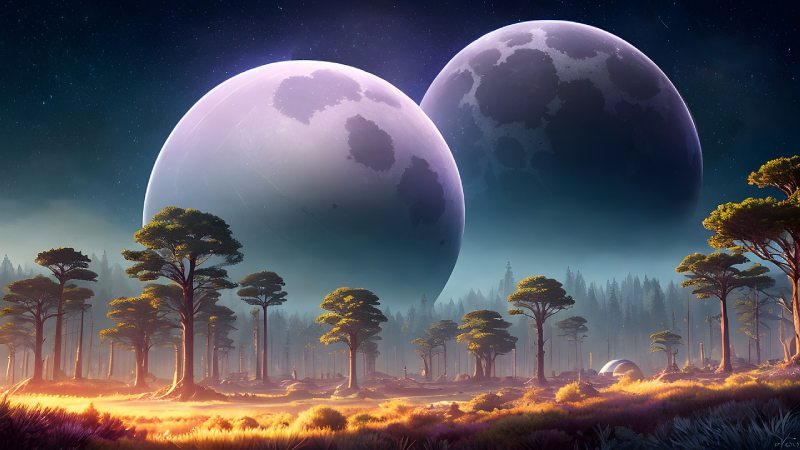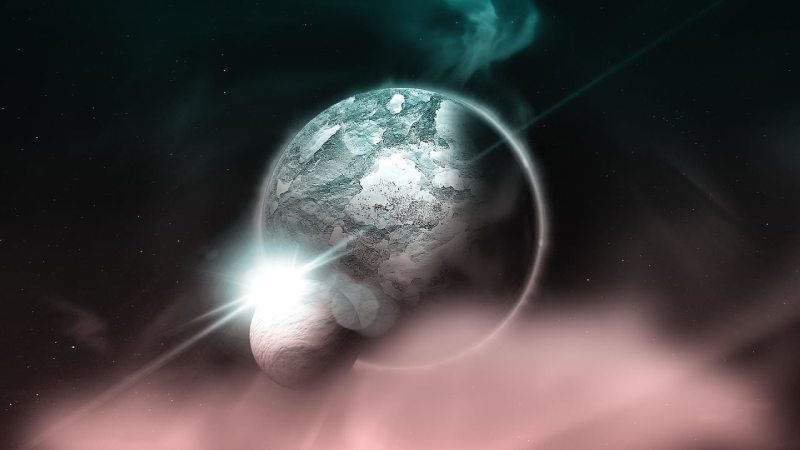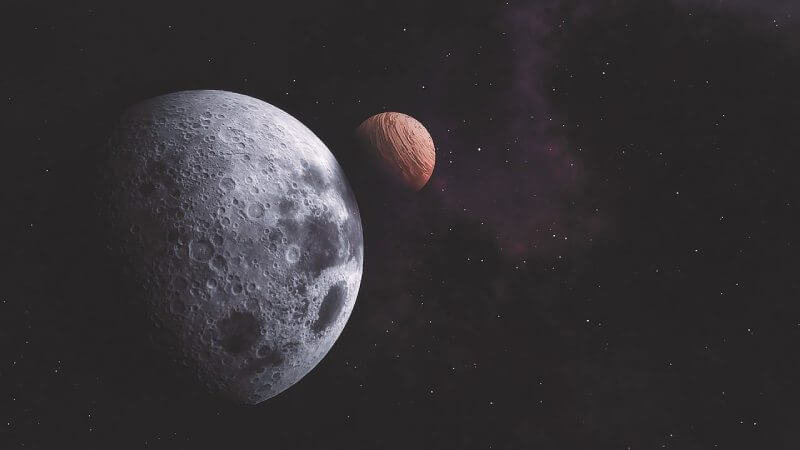Moons are one of the many celestial bodies that have captivated our imaginations for generations. We know that moons reside in a planet’s orbit and will orbit around the planet while the planet orbits around a star, but did you know that moons can have moons?
That’s right, a moon that is orbiting around a planet can also have its own moon that orbits around it. The moon orbiting around the parent moon has several different names, such as moonmoons, submoon, subsatellites, or a schmoon. For the sake of this article, we are going to be referring to these subsatellites as submoons.
The Submoon Phenomenon
In the universe, there are billions of stars. Of those stars, billions of planets orbit around them – each creating its own unique solar system. Each solar system has a parent star, orbiting planets, and likely orbiting moons.
Many planets have the capacity to generate enough gravitation pull to accumulate a moon of their own. So, sometimes many moons can be orbiting around just one planet. Due to the gravitation pull of Jupiter, it has 95 moons that orbit around it. As we know, Earth has one moon. Venus and Mercury are the only planets in our solar system that do not have moons.

In our solar system alone, we have 290 moons that orbit around their respective planets. But in the entire cosmos, there are so many moons that scientists can only speculate as to how many total moons – the number is well into the billions.
So, of these billions of moons that exist, do any of them have their own moon? A moon that circles a larger moon? A submoon?
Can a Moon Have Its Own Moon?
The answer to this question is a resounding “yes.” A moon can have its own moon, but it has to be in the most perfect of circumstances to make it possible. So, what is the circumstance that needs to be met for a submoon?
Well, let’s first talk about gravity. If we were to place an object in our moon’s orbit then it would start circling the moon. Seems pretty simple, right? Well, not so fast. The object would have to be the perfect distance away from the moon for it to stay in orbit because right when the object is placed in orbit, then the Earth will try to pull it in. The Earth is quite selfish and wants the moon to itself.
If the submoon is orbiting too far away from the moon then the Earth will easily yank it away or at least change the orbit. A couple of things can happen in this situation (a) the submoon will start orbiting the Earth, (b) the submoon would be flung out into space, (c) the object will be catapulted into the Earth or the moon. All of those scenarios would imply that the submoon is no longer a submoon.
According to researchers, only extremely large moons situated on wide orbits around their host planet would be able to suitably host their own submoon. Submoons orbiting smaller moons in closer proximity to their planet would face significant destabilization due to tidal forces. It would most likely cause the host planet to pull in the submoon or fling it off into space.
It is important to note that the submoon couldn’t be too close to the moon or the planet. If it is too close to the moon, then it would cause too much strain due to tidal forces. On the other hand, if the submoon is orbiting too close to the planet then it would force the submoon to leave the moon’s orbit. It just has to be an almost perfect environment for the star, the planet, the moon, and the submoon for it all to work out and remain stable.
Submoons In Our Solar System
Currently, we do not know of any submoons in our solar system. We do have a couple of moons that might be contenders for submoons, but it doesn’t appear that they have any. Jupiter’s moon Callisto and Saturn’s moons, Titan and Lapetus, and even our moon all have the capability of having their own submoon, but why don’t they?

To be perfectly honest, scientists aren’t quite sure why some of these moons don’t have their own submoons. Why haven’t they been able to pull something to their orbit and keep it there? There are some hypotheses as to why it isn’t a reality in our solar system (at least that we know of).
Some of the hypotheses include:
- Stability and Tidal Forces: Tidal forces play a crucial role in the dynamics of celestial bodies in close proximity to each other. Submoons orbiting moons would experience intense and strong tidal forces. The force of the tides would likely cause instability, and it could crash into the host moon or be ejected from the system altogether.
- Formation: The formation of a submoon is rare. It isn’t every day that a moon is just spontaneously formed and looking for a moon to orbit. Quite possibly, our solar system might just not have the necessary features to have submoons. Only more scientific research can help us prove or disprove this theory.
- Detection: We might have submoons! It would be quite possible that we have submoons, but they are so small that we don’t have the scientific advancements to be able to tell. There might be submoons circling Titan, Callisto, or Lapetus, but we are unable to detect their existence.
- Technology: It might all just come down to technology. We might have a lot of submoons in our solar system that we just can’t see. There might be other solar systems with large amounts of submoons that are being undetected. Until we can research an existing submoon, we will not be able to truly figure out what makes it occur.
It’s All Hypothetical
Right now, we don’t have any scientific evidence stating that submoons exist. We don’t have visibility on a moon having its own moon – but that doesn’t mean it isn’t a possibility. Under the right circumstances, a submoon could occur. A moon could have its own moon and remain stable if the perfect distance was created between the moon, submoon, planet, and host star. The alignment would have to be just right though.
There are a lot of things in our galaxy that we don’t know for sure if they are real, but we have enough scientific evidence to support our claims and our hypotheses. Researchers have not found any sign of human, plant, or animal life on any celestial body, but we know it is out there. They have enough evidence that points to the assumption that there is life on other planets.
In our entire cosmos, we know there are billions of planets, billions of stars, and billions of moons. It is reasonably suspected that out of the billions of possibilities in our universe that there are moons that have submoons.
Conclusion – We Are All Still Learning
We know a lot about the universe. It is absolutely amazing how much we know and how much scientists and researchers have been able to figure out about space. They have been able to see trillions of lightyears away and view planets that mirror Earth in many ways.
We have been able to study all of our planets in our solar system and we have detailed information about each one. We know their chemical makeup, their atmosphere, their terrain, and random facts about them.
NASA is confidentially sending astronauts up to space again – this time to set up a home base. We are going to start colonizing the moon so we can eventually colonize Mars.
The world of astronomy is absolutely mind-boggling.
Even with all of the things that we do know, there is even more that we don’t know. Every time we get an answer to our question, there seem to be 50 more questions that pop up in our brain. Researchers and scientists are constantly trying to learn as much as they can about the vast existence.
Will we ever discover that there are submoons somewhere out there? Don’t know. But we certainly are going to try!

